
Figures

Approximately two hours of BB150 ADCP data collected and averaged by Transect on the cold water trials (leg1) is shown here in plan view (top panel) and as a color contour for eastward and northward velocities. Several features are typical of data collected during the Healy trials: (1) In the top depth bin, the anomalous velocity in the direction of ship's motion in the top bin (in this case, northward and westward) are caused by ringing. (2) Depth penetration over the two-hour segment varies from 130m to 180m: factors such as local ocean acoustic scattering levels, sea state, and heading contribute to the variability in effective depth penetration.
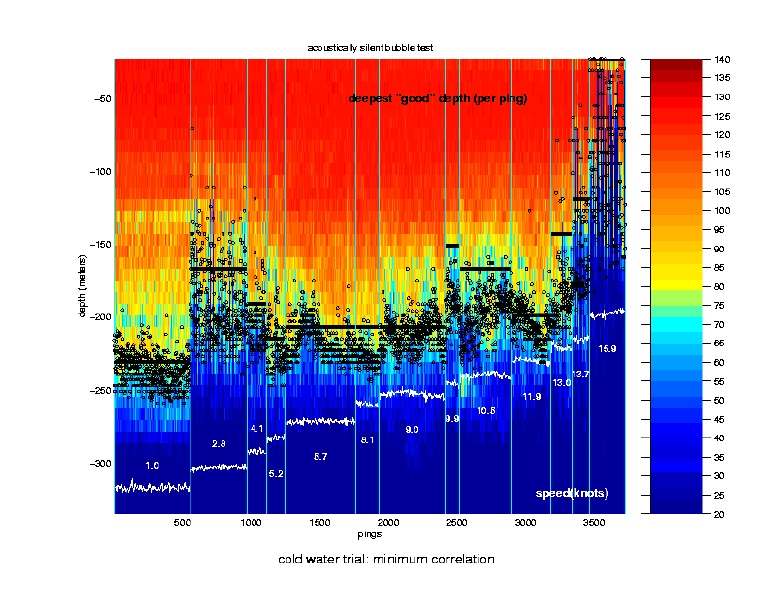
Minimum correlation among all four beams is colored as a function of depth during a test wherein speed was incremented from 1 to 16 kts over the course of nearly 5 hours. The ship was held at each speed for about 20 minutes; data collection parameters were sometimes changed during a constant-speed interval. Five to twenty minutes of continuous data collection were available at each speed. These chunks of data are shown here separated by light blue lines that represent intervals of 5-20 minutes. The white line and numbers show the ship's speed in knots. On a ping-by-ping basis, the effective range (black circles) can be estimated as the shallowest depth where the minimum correlation falls below 64. Processed data are usually averaged over 5-minute ensembles, during which some minimum percentage of pings must be good in each depth bin for which a valid average is obtained. The effective range (black line) for processed data is therefore the point where the percent good falls below a threshold, chosen here as 80%.
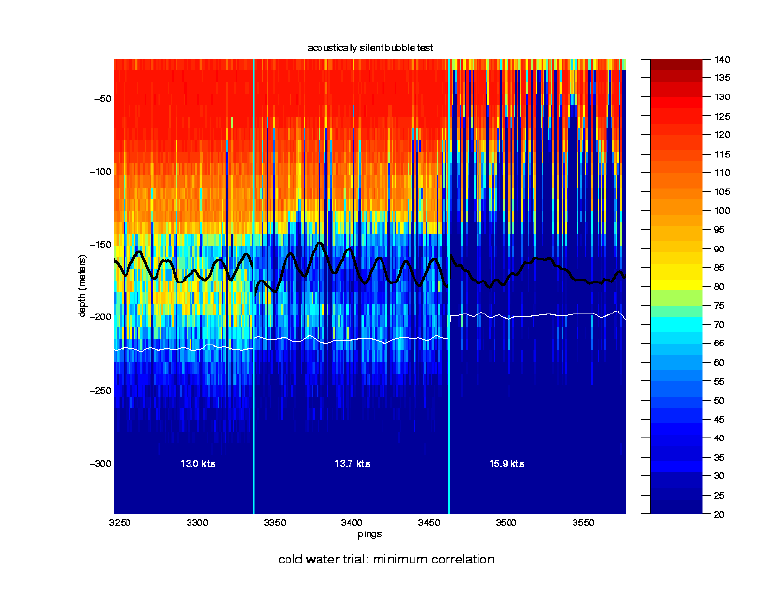
The three highest ship speeds from Figure 2 are shown here in order to
better see the effects of bubbles at higher speeds. The heavy black
line is a scaled heading of the ship 3*(H - HMEAN)). At 13 kts, five
bubble events are seen, each sampled by a single ping. At 14 kts, the
time interval between events is similar, but the events are occurring
with a longer duration (3-8 pings). The low correlation bubble events
are obviously associated with times when the black line slopes down to
the right (the ship is moving most rapidly to port). At 16 kts,
individual events are difficult to distinguish, and very little data
is valid below 5 bins.
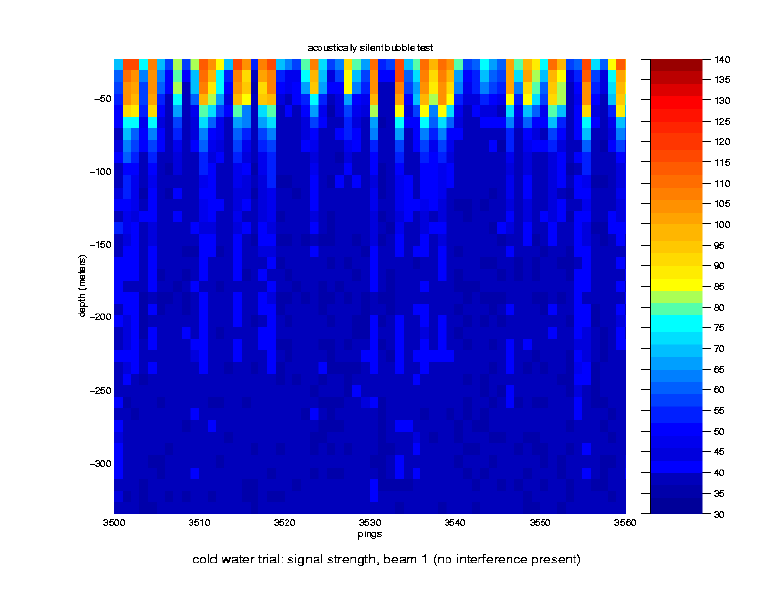
Signal strength from beam one, for the 16-kt segment from Figures 2
and 3. The layer of bubbles under the transducer causes a decrease in
amplitude at a given depth (in this test at ship speeds under 8kts,
this effect was overshadowed by ocean scattering variability, (not
shown)), a very slight increase in the general noise floor (not
perceptible in this plot), and single pings or groups of pings with a
slightly lower noise floor and extremely weak signal strength even in
the top bin (for example, pings 1, 9, and a group of 3 near the center
of the time range).
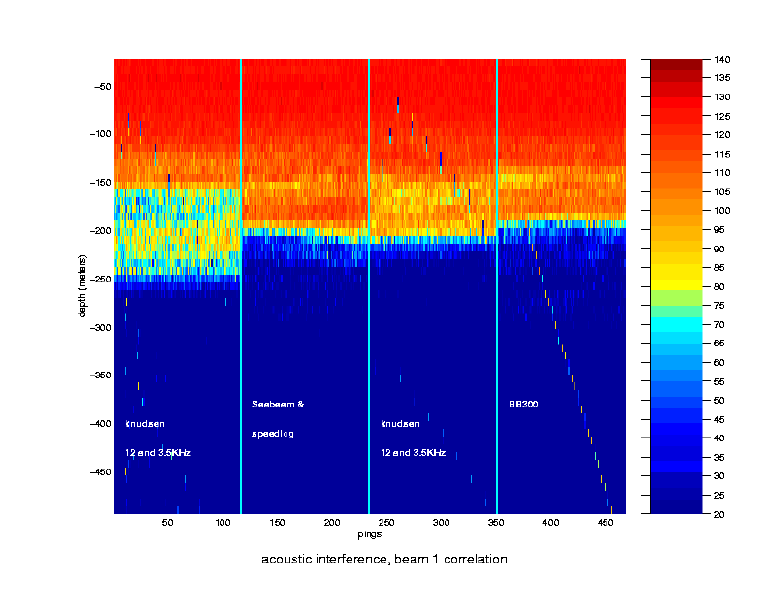
Beam 1 correlation (BB-150) during tests of interference with other sonars. The Knudsen 3.5kHz sub-bottom profiling chirp was the most obvious in the BB150 signal (Panels 1 and 3). It should not affect the velocities since the chirps have a low correlation. The 350 kHz speedlog and the SeaBeam showed no interference in the BB150 signal (Panel 2). The BB300 pings were obvious below the depth of valid returns (Panel 4). It should be noted that although these acoustic interference signals did not affect the data during this test, we were nearly stationary and in relatively calm seas. In another instance, when steaming over water 300m deep, velocities in occasional pings and bins were anomalous, possibly due to a combination of acoustic interference and reverberation between the bottom and the ocean's surface. A median filter of the velocities prior to averaging would eliminate this problem.
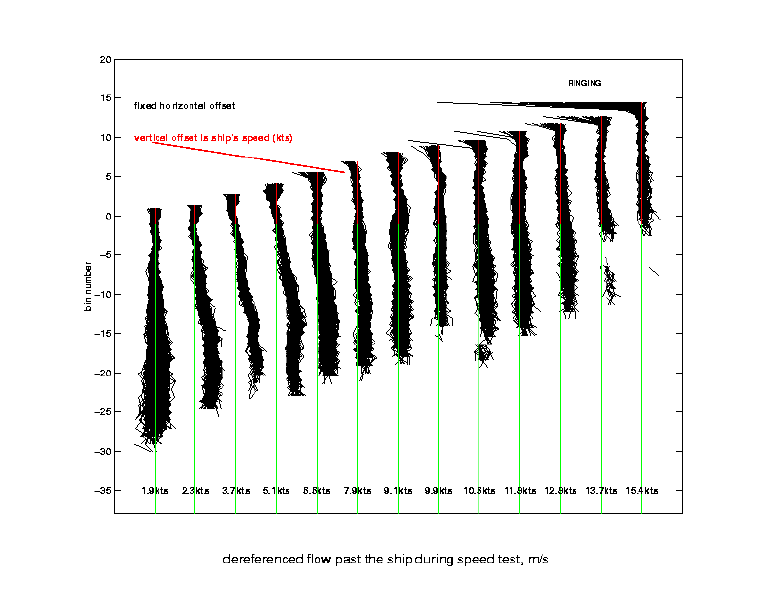
Single-ping velocities measured by the BB150 in the direction of the
ship's heading, and referenced to the average of bins 3-8. Ensembles
for each speed are offset horizontally in 1-m/s increments, and
vertically by the ship's speed in knots. Ringing is obvious (a bias
towards zero (left) in the top bin) for ship speeds above 11 kts, and
more subtle at lower speeds.
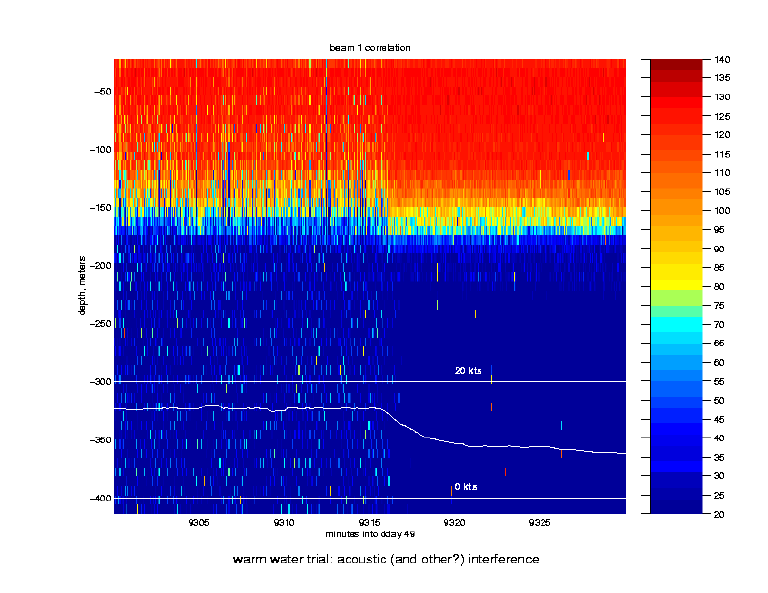
Beam 1 correlation, showing the unidentified interference we call
"hash", which was present intermittently during both warm and cold
water trials. Characteristics include: (1) high correlation and signal
strength in all beams at an isolated bin; (2) the signal appears at
intervals of 3 bins, or roughly once every 0.037 sec. In the example
shown here, the hash stopped when the speed dropped, shortly after
9315. The few subsequent correlation glitches are from acoustic
interference by other sonars.

Minimum correlation among all four beams, showing the effect of hash
and bubbles. This segment of data lasted 20 hours and included (A) a
slow survey at 2kts, (B) a Seabeam canyon survey at 12kts, and (C)
steaming at 16 kts. Samples at each speed are shown. Hash can be seen
in the first panel (A) as regular high correlations below 200m. Hash
is less clear in panels B and C, but is present at lower correlations.
Bubbles are evident in panel B as the three vertical stripes of low
correlation between 50 and 150m. Bubbles obliterate many pings in
panel C, reducing the correlation to very low values.
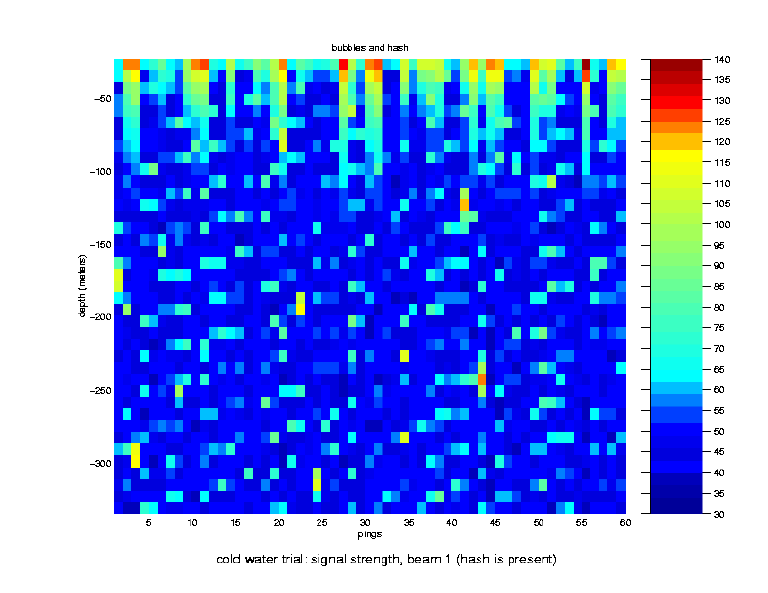
Signal strength from a segment of the data sampled by Panel (C) of
figure 8, showing the effect of bubbles and hash together. Compare to
Figure 4, which also shows the effect of bubbles at 16 kts, but
contains no hash. The hash in Figure 9 is seen as anomalously high
signal strengths below bin 10, often occurring every third bin in the
vertical in a given ping. The bubbles cause the generally low signal
strength, with virtually no signal at all in some pings and short
groups of pings. Note that in the pings when signal strength is low
throughout the water column, the hash is still visible close to the
surface; it seems unaffected by the bubbles. This indicates that the
hash is not acoustic noise coming from outside the ship.

Histograms of single-beam velocity from the hour-long samples (A,B, C)
in Figure 8. These velocities were screened only to reject minimum
correlations under 64. The number of points available in (C) is far
fewer than in (A) or (B), because of the effect of the bubbles. Note
that the beam velocities in panel (A) show a bimodal distribution.
The correct velocity peak is the large red hump. The second hump (to
the left, or negative side of the main hump) consists entirely of data
in the hash region: these data were included because their anomalously
high correlations did not get screened out. Opposite pairs of beam
velocities from the negative hump will yield high vertical velocities;
but the vertical velocity estimates from orthogonal beam pairs are
often similar, so the error velocity can be low. The bridge connecting
the two humps shows the bias in the transition region between
shallower bins where there is a valid signal from the water, and the
deeper bins where the only signal is from the hash.
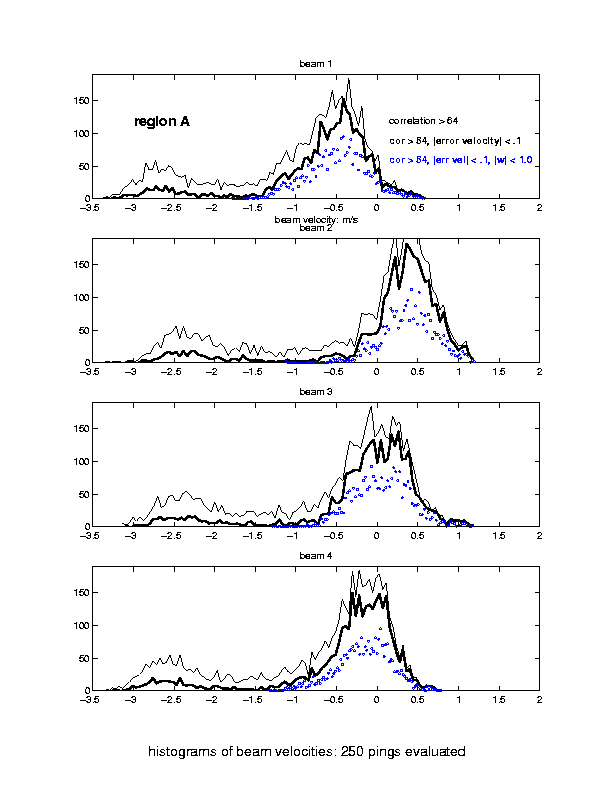
istograms of Panel A beam velocities from Figure 10 are shown with
increasingly stringent editing criteria applied. The red lines in
this figure are the same as the red lines in Figure 10: histograms of
beam velocities, one per beam, with correlations over 64. If
velocities with an absolute value of error velocity greater than 0.1
m/s (a very stringent criterion) are rejected, many points from the
second velocity hump are removed and the number of points in the main
hump also decreases. If data are further screened to reject absolute
values of vertical velocity greater than 1.0m/s, the result is the
small circles. The data from the second hump is now gone, but about
half of the points in the main hump are also lost.
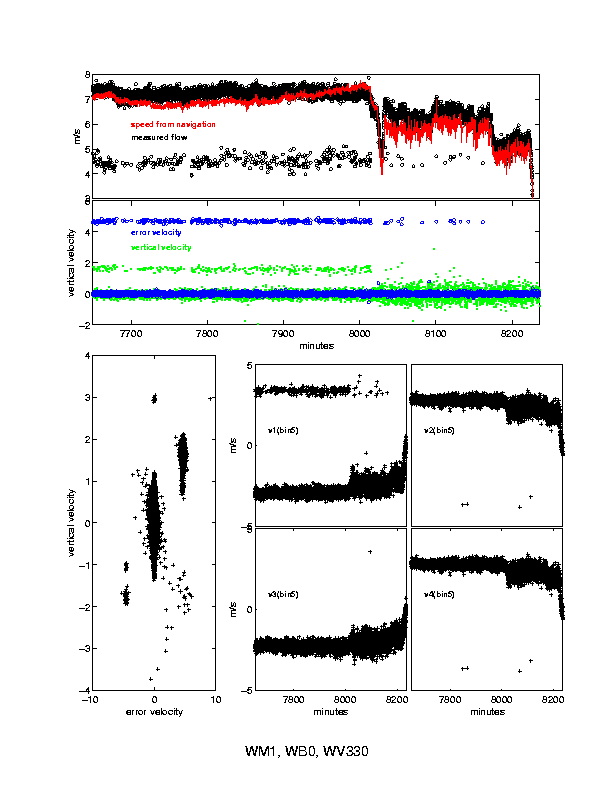
The top panel shows the speed of the ship over ground computed from navigation (red) and the measured flow past the ship (black circles). Each one of the circles near zero corresponds to time when one or more of the beam velocities exceeded the ambiguity interval, 3.3 m/s. From timestamp 7690-7900 the ship's speed was below 14 kts, but there are a significant number of ambiguity wraps. From timestamp 8000-8150 the ship's speed ranged from 11-12kts and in this region there was still on average one wrap every 7 minutes over 130 minutes. These wraps show up in both w and the error velocity (second panel). The bottom right four panels show the individual beam velocities for bin 5. Beam 1 shows the highest level of wrapping in part because of its orientation relative to the keel, and in part because of its vertical alignment. The bottom left panel shows the vertical velocity plotted as a function of error velocity. Note that an error velocity editing criterion would eliminate most of the wrapped points, but there would still be a little cluster at +3m/s requiring editing with a vertical velocity threshold.